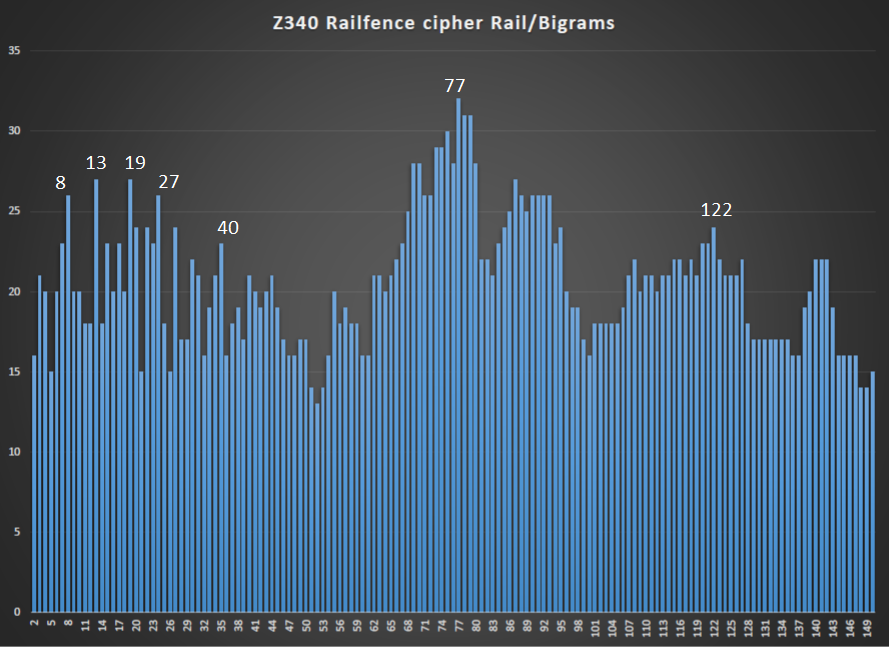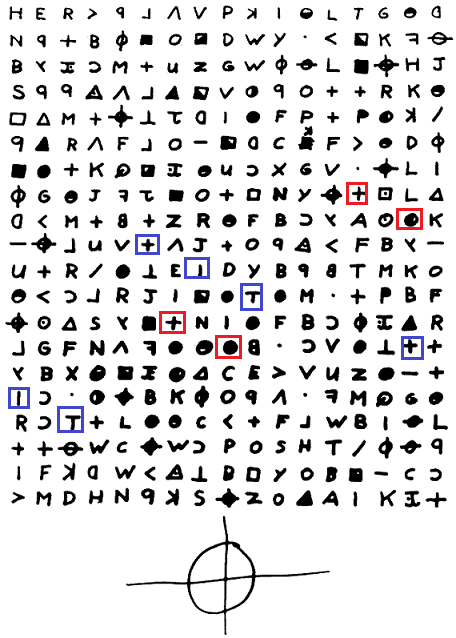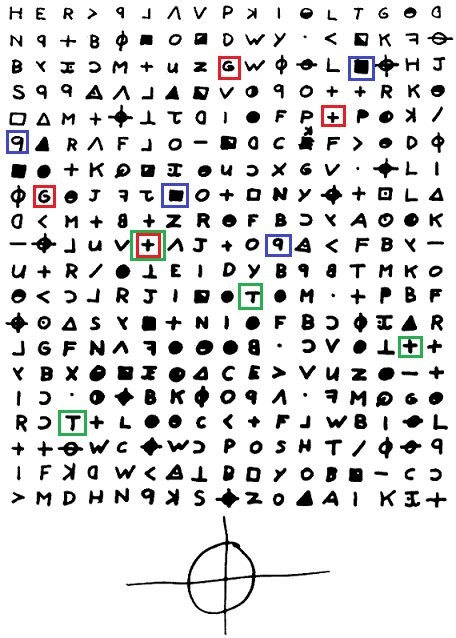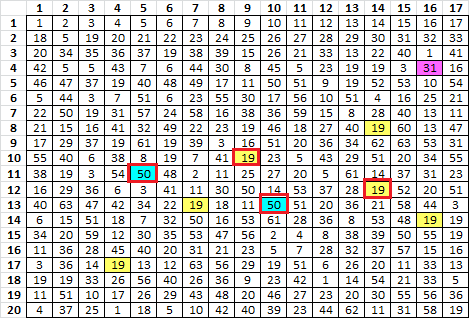Smokie, that’s an interesting way to link the phenomena. Based on https://docs.google.com/spreadsheets/d/ … sp=sharing I suspect there are also 20 shared positions among bigrams at period 39 and kasiski shift 78. At period 39, do you also find ngrams that are spaced apart by multiples of 13?
So strange, all these multiples of 13. And the "my name is" cipher happens to have a length of 13.
Smokie, your "periodic bigrams that are also periodic" are easier to spot when you write the cipher to width 26:
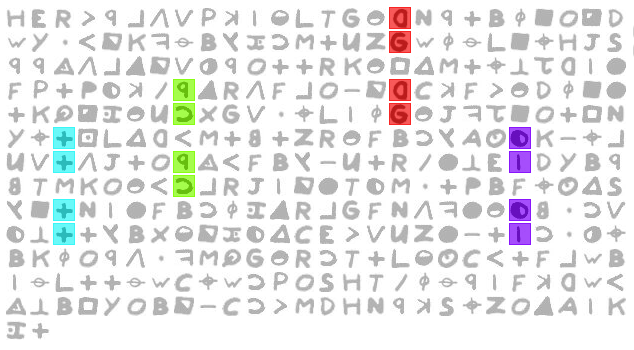
Besides the coincidence with the "my name is" cipher of length 13, a typical plaintext alphabet has 26 letters in it, which produces another coincidence with your observation.
Last night i ran through the Railfence cipher 2 to 100 and used
Akdecrypt test the output All scored around 19k to 20k with no solution.
I currently have no plausible answer to the pivots except an angular striping transposition.
Thans David for having a look at my PT idea but i think we can conclude i am pretty much pissing in the wind with it.
Smokie those are some interesting observations
Thanks for sharing
Regards
Bart
At period 39, do you also find ngrams that are spaced apart by multiples of 13? So strange, all these multiples of 13. And the "my name is" cipher happens to have a length of 13.
I haven’t looked at any other spacing or at the number 13 yet, but was also thinking about it.
Besides the coincidence with the "my name is" cipher of length 13, a typical plaintext alphabet has 26 letters in it, which produces another coincidence with your observation.
I have also been thinking about the plaintext alphabet length of 26.
I have considered some type of multiple transposition, with more than one consecutive inscription shapes that could put the plaintext period 1 bigram repeats at period 19. One that also causes these other phenomenon that we are looking at. I have played around briefly with multiple consecutive inscription rectangles, and they do move plaintext around in patterns.
Or some type of encryption where, although not a Vigenere step before homophonic substitution, ciphertext is conditioned upon position. Some system that uses the number 13.
I have also considered that he may have just written out the alphabet forward, backwards, forwards, and then backwards again, etc. Then encoded it with the homophonic symbols. But that wouldn’t explain the period 19 repeats. Maybe I should consider this in more detail.
The number 13 reminds me of the ROT13 cipher.
I am definitely not ready to dismiss the period 78 unigram repeat spike. I would like to explore these spacing phenomenon in more detail, and it may take some time. I don’t want to miss something important. And of course, find the most improbable and compare with other messages.
Last night i ran through the Railfence cipher 2 to 100 and used
Akdecrypt test the output All scored around 19k to 20k with no solution.
I currently have no plausible answer to the pivots except an angular striping transposition.
Thans David for having a look at my PT idea but i think we can conclude i am pretty much pissing in the wind with it.Smokie those are some interesting observations
Thanks for sharing
Thank you. I have really enjoyed your contributions and appreciate your participation. I am excited about your findings.
I have experimented with railfence to try to explain the period 19 bigram repeats, using chunks of plaintext with two rows and I think 39 columns. It is the same as using an inscription rectangle that is two columns wide, which is found in some of the cryptography books of the time. But I found that it is very difficult to generate so many period 19 bigram repeats because one message chunk transposed doesn’t have any relationship with a following message chunk transposed so that we get diagonal rows of period 19 repeats.
I use my subconscious a lot to work on the 340. Last night I made my post showing that both the leftmost and rightmost symbols of the period 78 unigram repeats shared positions with the period 26 bigram repeats. This morning I woke up wondering if the period 26 bigram repeats were spaced at a period of 78. I got up, checked it, and they were. That was a really weird experience.
At period 39, do you also find ngrams that are spaced apart by multiples of 13? So strange, all these multiples of 13. And the "my name is" cipher happens to have a length of 13.
I haven’t looked at any other spacing or at the number 13 yet, but was also thinking about it.
I have also been thinking about the plaintext alphabet length of 26.
Well here is some more 13 and 19 spikes for you guys to chew on. I have no spike at 26 but i do at 27 and not 39 but at 40 and not at 78 but at 77.
This is a bigram hit vs Railfence cipher at X rails.
Due to the nature of the Homophonic layer it really is knocking my tools and intuition forcing me to revisit my thinking.
I have written a program where I can drop in simple transposition programs and quickly score the output based on the key input using bigram counting.
I can then drop the output to a csv for plotting in excel.
Thank you. I have really enjoyed your contributions and appreciate your participation. I am excited about your findings.
I am glad that I am bring some value to the group and pleased to be working with serious people in a co-op manor.
I have not found any one in the ACA community that is active on Z340
I have experimented with railfence to try to explain the period 19 bigram repeats, using chunks of plaintext with two rows and I think 39 columns. It is the same as using an inscription rectangle that is two columns wide, which is found in some of the cryptography books of the time. But I found that it is very difficult to generate so many period 19 bigram repeats because one message chunk transposed doesn’t have any relationship with a following message chunk transposed so that we get diagonal rows of period 19 repeats.
I think i will ponder your statement some more…. All these clue point to something
I use my subconscious a lot to work on the 340.
Lol same. I have had many experiences in the past when I have dreamt the solution to a problem.
Regards
Bart
Hi Guys,
Just want to consolidate some of my ideas/assumptions and theories or at least kick them around so as to try and focus and take stock of what we know.
I would appreciate any input.
1/ There is at least another layer of encryption below the Homophonic due to no one being able to solve with hill climbers.
2/ From the KE experiments we know that there is little to no change of a underlying Vigenere cipher.
3/ From my PT CHI2 experiment I would be more inclined to consider an underlying transposition cipher. however the validity of this questionable.
4/ The KE has highlighted some quirks which correlate to an anomaly in the periodic bi gram search
5/ My recent rail fence experiment is showing similar anomalies at same/very similar locations to the KE and Periodic experiments.
6/ Pivots could be explained by an angular (diagonal) striping method.
7/ The prime phobia observation is likely to be tied in with the Odd /even observation as only odd values are potential candidates for prime.
Regards
Bart
Hi Guys,
Just want to consolidate some of my ideas/assumptions and theories or at least kick them around so as to try and focus and take stock of what we know.
I would appreciate any input.1/ There is at least another layer of encryption below the Homophonic due to no one being able to solve with hill climbers.
2/ From the KE experiments we know that there is little to no change of a underlying Vigenere cipher.
3/ From my PT CHI2 experiment I would be more inclined to consider an underlying transposition cipher. however the validity of this questionable.
4/ The KE has highlighted some quirks which correlate to an anomaly in the periodic bi gram search
5/ My recent rail fence experiment is showing similar anomalies at same/very similar locations to the KE and Periodic experiments.
6/ Pivots could be explained by an angular (diagonal) striping method.
7/ The prime phobia observation is likely to be tied in with the Odd /even observation as only odd values are potential candidates for prime.
Regards
Bart
Will give input soon. But I have to make this post and get going for a short while.
EDIT:
1/ I agree.
2/ I agree.
3/ There are 121 positions covered by the period 19 repeats, which is 35.6% of the entire message. By contrast, there are only 80 positions covered by the period 1 bigram repeats, which is 23.5% of the message. Doranchak and I both proved that messages can be created with comparable stats, but without transposition. When I did it, there were a statistically high count of period 19 repeats in the plaintext, and I manipulated the key so that the period 1 plaintext repeats would be diffused more and the period 19 plaintext repeats would be diffused less. However, Doranchak and Jarlve untransposed the message in a lot of different way to re-connect the period 19 repeat ciphertext as period 1 ciphertext, and there was no solve. There could be an untried transposition, some other complications with the transposition, or another cipher step.
4/ I agree, but I don’t know how significant it is.
5/ I don’t know.
6/ I agree.
7/ I think so also, if it is not just a statistical anomaly.
I made a coincidence count chart for the period x bigram repeats. I found all of the period 1 bigram repeats, and then found the spacing of them. Then I found all of the period 2 bigram repeats and found the spacing for those. And so on through to period 170 bigram repeats.
There are 147 occurrences ( a massive spike ) where you have AxB exactly 78 positions away from another AxB, where A is the first symbol in the bigram repeat, x is the count of positions to B, and B is the second symbol in the bigram repeat. There is another curious spike at x = 35, and little spikes at 71, 48, 39 and 32. I think that I may be just multiple counting the period 78 unigram positions as they relate to each other, but not sure. Will have to take a closer look.
EDIT: The spikes are just the period 78 unigram positions counting each other because they create a lot of different period x bigram repeats. Same thing with the spike at 35, but I haven’t looked at the different periods yet.
I checked all of the period x bigram repeats, and made a tally of those spaced by 78 positions. Left column is the period, and right column is the count. Only those with count of 2 are listed. I don’t really see any interesting patterns, except period 26 and a few at period 19 and 38 ( NOT period 39 ).
26 4
19 3
23 3
38 3
45 3
47 3
58 3
69 3
111 3
116 3
135 3
2 2
5 2
13 2
15 2
16 2
20 2
21 2
22 2
31 2
32 2
46 2
49 2
51 2
64 2
65 2
66 2
67 2
77 2
84 2
85 2
90 2
93 2
95 2
103 2
109 2
Here are the period 19 bigram repeats spaced by 78 positions. There is one repeated trigram:
And here are the period 38 ( NOT period 39 ) bigram repeats spaced by 78 positions:
For the 340, I found all period x bigram repeats where x is a divisor of the position spacing of the repeat. Here is the table. On the left is the period. On the right are the position spacings. I must have gotten lucky when checking period 26 before, as I did not find any other period with such a high count of the same position spacings.
There are a lot of period 2 and period 3 bigram repeats where the period is a divisor of the position spacing of the repeats. But that is to be expected, because a lot of numbers can be divided by 2 or 3.
Besides the period 26 bigram repeats, I don’t see anything particularly interesting.
For the 340, I found all period x bigram repeats where x is a divisor of the position spacing of the repeat. Here is the table. On the left is the period. On the right are the position spacings. I must have gotten lucky when checking period 26 before, as I did not find any other period with such a high count of the same position spacings.
There are a lot of period 2 and period 3 bigram repeats where the period is a divisor of the position spacing of the repeats. But that is to be expected, because a lot of numbers can be divided by 2 or 3.
Besides the period 26 bigram repeats, I don’t see anything particularly interesting.
This is an interesting observation.
I feel this points to a cipher parameter like rail size in railfence foe example. Hence why i see the spikes i posed before that correlate to your numbers. Now we just need to track down what it is.
EDIT i also feel that this indicate the exsistance of a valid message rather than a troll.
Regards
Bart
By "rail size", do you mean the number of rows in a rail fence cipher like this one?
I would say that this is a 25 x 3 railfence cipher because there are 25 columns and 3 rows. Just checking.
Yes, My plot the other day shows the Rail number (key) verse Bigrams.
I am exploring other versions of Railfence including inverse, offset and Redefence.
As it is a zigzag every rail number would line up so this is why i have hits at 13,26 etc etc
That is why i think we are seeing a cipher artifact but have not identified it yet.
EDIT
http://codepad.org/MEPN90S2
Click the output link for the output data, I will be adding another score metric suggested by Doranchak when i get time
Regards
Bart
I am glad that you are bringing this up, not just railfence but any transposition idea, because there is something that I have wanted to do for a while and haven’t gotten around to it.
Below are the period 19 bigram repeat positions shaded yellow. The message on the left and right are both the 340, but I show it twice for clarity. There are a lot of consecutive diagonal shaded positions. Some are shown boxed blue on the left, and others boxed green on the right for clarity. I made the picture last year, and I think that I only boxed where there are at least three consecutive diagonal ( period 19 ) positions.
Let’s say we have a railfence cipher that is 38 columns x 2 rows, and we transpose 38 plaintext at a time. That is the easiest way to re-produce the period 19 repeats – except that is still not easy because we are only transposing 38 plaintext at at time. Each individual transposed message chunk is independent of the previous and following message chunk for transposition purposes, making it difficult to result in so many consecutive diagonal positions that test positive for period 19 repeats. Even with a railfence that is designed to maximize the count of period 19 bigram repeats, it is still very difficult to cover 35% of the entire message.
I am going to update my spreadsheets so that they count the number of consecutive diagonal positions where there is at least a group of three; I want to find some type of way to count them and compare with other messages, including route transpositions, railfence transpositions, non-transpositions, etc.
